One of the most memorable of our 2024 road trips began with a narrowly averted calamity.
For a change, this one did not involve mechanical problems with our Next Chapter camper van or difficult weather conditions on the road. In fact it occurred far away from our physical location at the time, although this did not lessen its seriousness or the complexity of the challenge it presented us.
We were on the second day of our planned 23-day trip to the Canadian Rockies in early autumn. Having camped the first night in the Inyo National Forest near eastern California’s Mono Lake, we were headed that Saturday for Lamoille Canyon and a campground in Nevada’s Ruby Mountains. We were several hundred miles from home when I received a mid-afternoon text from my daughter, Allison, asking me to call when we had cell service. I was driving along some rural road in Nevada , so my partner Leslie called her and put her on speaker.
“Hi Dad,” she said. “Umm, a tree fell on your house.” (Or words to that effect; I wasn’t taking notes.)
“Holy shit!” I said.” (Or words to that effect; I still wasn’t taking notes.)
I found a wide spot on the shoulder and pulled off the road to continue our conversation. She texted photos taken at my house in Ojai that confirmed a tree had indeed fallen on it. One of the large coast live oaks in my back yard, a woodland haven that bewitched me the first time I saw it and convinced me to buy the place a decade ago, had inexplicably toppled during calm and dry weather, its canopy coming to rest on the roof.
My sister Stephanie had arrived that day from out of town, planning to stay at my place with some friends for several days to play in a charity golf tournament, and called Allison when she discovered the situation. My daughter lives only a few miles away, and she promptly showed up to scope things out.
In the moments after her call and texts, I had no idea what to do. I could see in the photos that the toppling tree had crushed part of the large pergola that covers my patio and supports a dense network of wisteria vines, but it was difficult to tell whether the house itself had suffered structural damage because the impact zone was obscured by the oak’s canopy. My sister later reported that the tree was still creaking and moving, and that the interior of the house revealed no obvious damage. But it clearly would be impossible to fully evaluate the condition of the roof until the tree was removed.
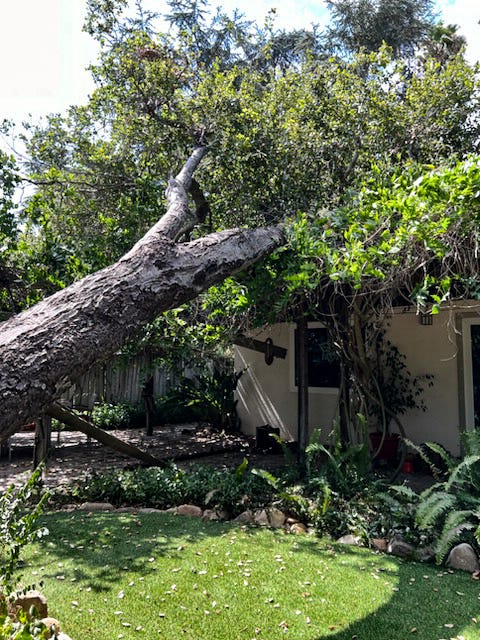
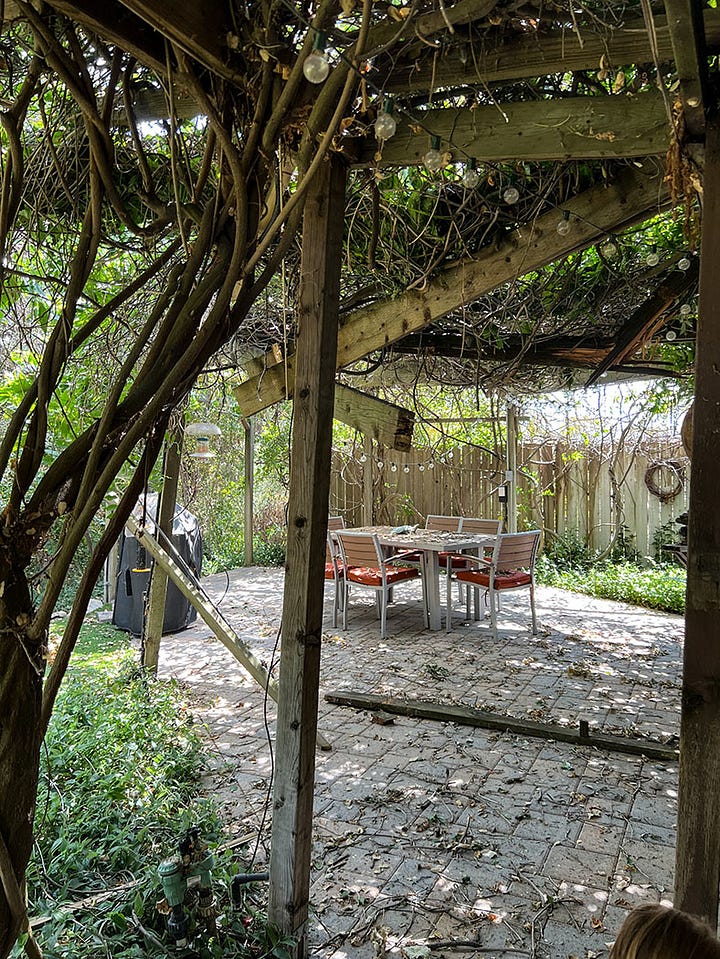
My initial inclination was to abort the trip and return home, to deal with the matter in person, even though Allison had offered to make whatever arrangements I thought best. Leslie and I discussed turning back, but decided we had invested too much time and commitment (some of it in the form of nonrefundable payments for lodging and camping reservations) into the trip to cancel it. This was our second attempt to explore the Canadian Rockies, the first having been torpedoed two years earlier by a pre-trip injury, and the disappointment of another missed opportunity just seemed too great to consider as a first response to the possible calamity in Ojai.
Leslie and I swapped seats, and as she drove I began trying to solve the problem by cell phone. This actually turned out to be easier than I initially anticipated. I contacted a tree service crew I’ve used before, and they agreed to come inspect the situation and provide a cost estimate. They came to my house the next day, a Sunday, and called me while surveying the situation. Long story short, the crew came out on Monday and by the end of the day the toppled tree was gone and several other trees on the property had received long-needed trimming.
Allison sent me post-removal photos of the impact zone, and although the roof did not appear to have suffered significant damage it still was impossible to be sure without closer inspection. It was clear that the house remained secure from the elements, however, so we pressed on with our trip, which meant I had three weeks to worry my way across Canada before I could see the aftermath for myself. Fortunately, the Rockies provided plenty of distraction.
Upon our trip’s conclusion, I returned to my place with trepidation. The tree crew had done a good job removing all evidence of the fallen oak along with a mess of wisteria that had been tangled up with its branches after the crash. They’d left behind the shattered redwood post, beams and crossbars of the pergola that had taken the direct impact of the tree’s heavy trunk. I cleared them away, and climbed a ladder to examine the roof.
Miraculously, it was undamaged except for a few minor gouges in the asphalt shingles and a dent in the gutter. The tree had landed at such an angle that the pergola had slowed the impact and borne most of the weight, and the tree just missed the electrical, phone and cable wires running to the house from the utility pole at my rear property line. After pondering options for a couple of weeks — should I hire someone for the rebuild, or tackle it myself? — I took measurements, ordered lumber and started rebuilding the pergola, completing the repairs almost exactly three months after the treefall.
Now I am waiting for the wisteria to do its part and regrow across the gap created by the crash. If you know anything about wisteria’s growth habits, you probably share my optimism that it won’t take long once spring arrives. The episode nonetheless reinforced a truth that distinguishes the van life Leslie and I lead from that of people who have committed to full-time vagabondage: We maintain a fixed base — my house in Ojai, and Leslie’s in Ventura, with its entertaining complement of cats — to which we remain emotionally tethered no matter how far afield the road leads us. We know a trip has been long enough when we start missing home.
By the numbers
Despite worrying about the fate of my roof, we thoroughly enjoyed that trip, perhaps the most scenically spectacular of our journeys this year (although it had significant competition for that title). We started 2024 with a journey to a remote lagoon on the Pacific shore of Baja California, where Leslie high-fived a gray whale. In spring, we explored more of our favorite red-rock country in Utah, and we kicked off summer by following in the footsteps of pioneers, traders and indigenous hunters along the routes of the Santa Fe and Oregon National Historic Trails. In later summer we witnessed the revival of a river and its sacred salmon in Klamath country, celebrated fall amid the glorious geology and wildlife of the Canadian Rockies, and greeted winter by encountering fantastic beasts in the California desert.
And now, as 2024 draws to a close, here’s a by-the-numbers summary of where we went and what we did over the past 12 months.
· U.S. states in which we camped: 14 (Arizona, California, Colorado, Idaho, Kansas, Missouri, Montana, Nebraska, New Mexico, Nevada, Oregon, Utah, Washington, Wyoming)
· Canadian provinces in which we camped: 2 (Alberta, British Columbia)
· Mexican states in which we camped: 1 (Baja California Sur)
· Miles traveled: 13,000+
· Days on the road: 75
· Nights under a roof: 29
· Nights in the van: 44
· Nights in a tent: 2
· U.S. national parks visited: 5 (Canyonlands, Gateway Arch, Glacier, North Cascades, Zion).
· Canadian national parks visited: 5 (Banff, Glacier, Kootenay, Mount Revelstoke, Yoho).
· Favorite day hike: Fairyland forest and glacial lake, Yoho National Park.
· Favorite developed camp site: West Fork Methow River, Okanogon-Wenatchee National Forest, Wash.
· Runner-up: Barton County Park Campground, Boring, Ore.
· Favorite boondocking site: Upper Rogue River off Hamaker Campground Road, Rogue River-Siskiyou National Forest, Ore.
· Runner-up: Near Hamburger Rock outside the Needles District, Canyonlands National Park, Utah.
· Favorite Hipcamp site: Cloud Peak Llama and Alpaca Ranch, Casper, Wyo.
· Runner-up: Land of the Dead cemetery outside Madrid, N.M.
· Favorite travel souvenir: Bottles of craft gin and vodka from Monashee Spirits Distillery in Revelstoke, B.C.
· Least favorite souvenir: Receipt for emergency van repairs from Mercedes-Benz of Medford, Ore.
I appreciate all of you who follow along with us on our journeys by subscribing to Next Chapter Notes. Writing about our experiences is an enjoyable way of both reliving them and making sense of them, fitting our encounters with people and landscapes into a larger context enriched by art, history, science and memory. It’s even more of a pleasure to share them with a community of readers who share our capacity for awe in the presence of profound natural beauty and our fascination with the rich human tapestry woven about our remarkable home region, the West. Special thanks to those of you who took the time to reach out and comment about stories you found enjoyable and/or interesting. I look forward to continuing those conversations in 2025.


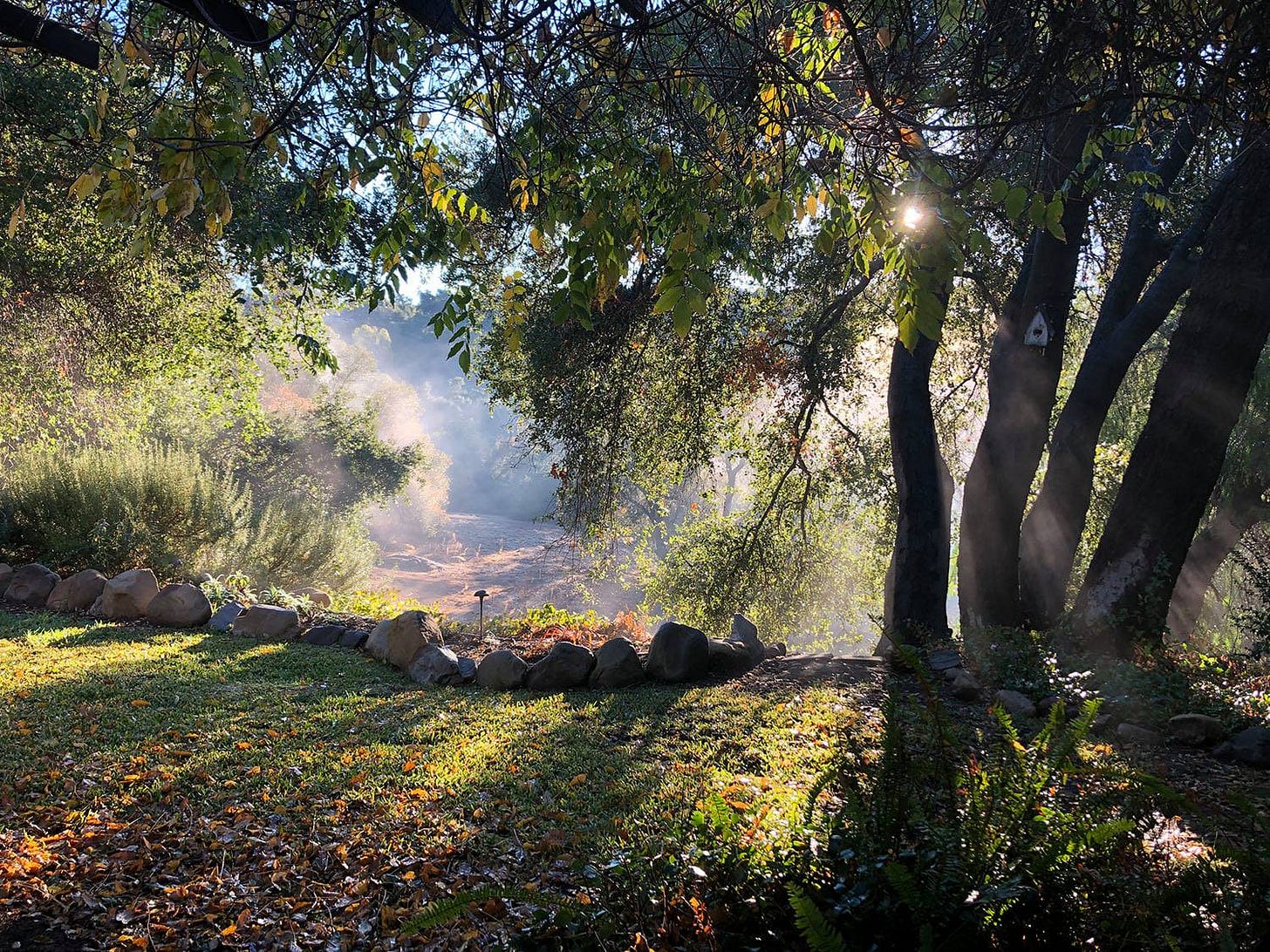
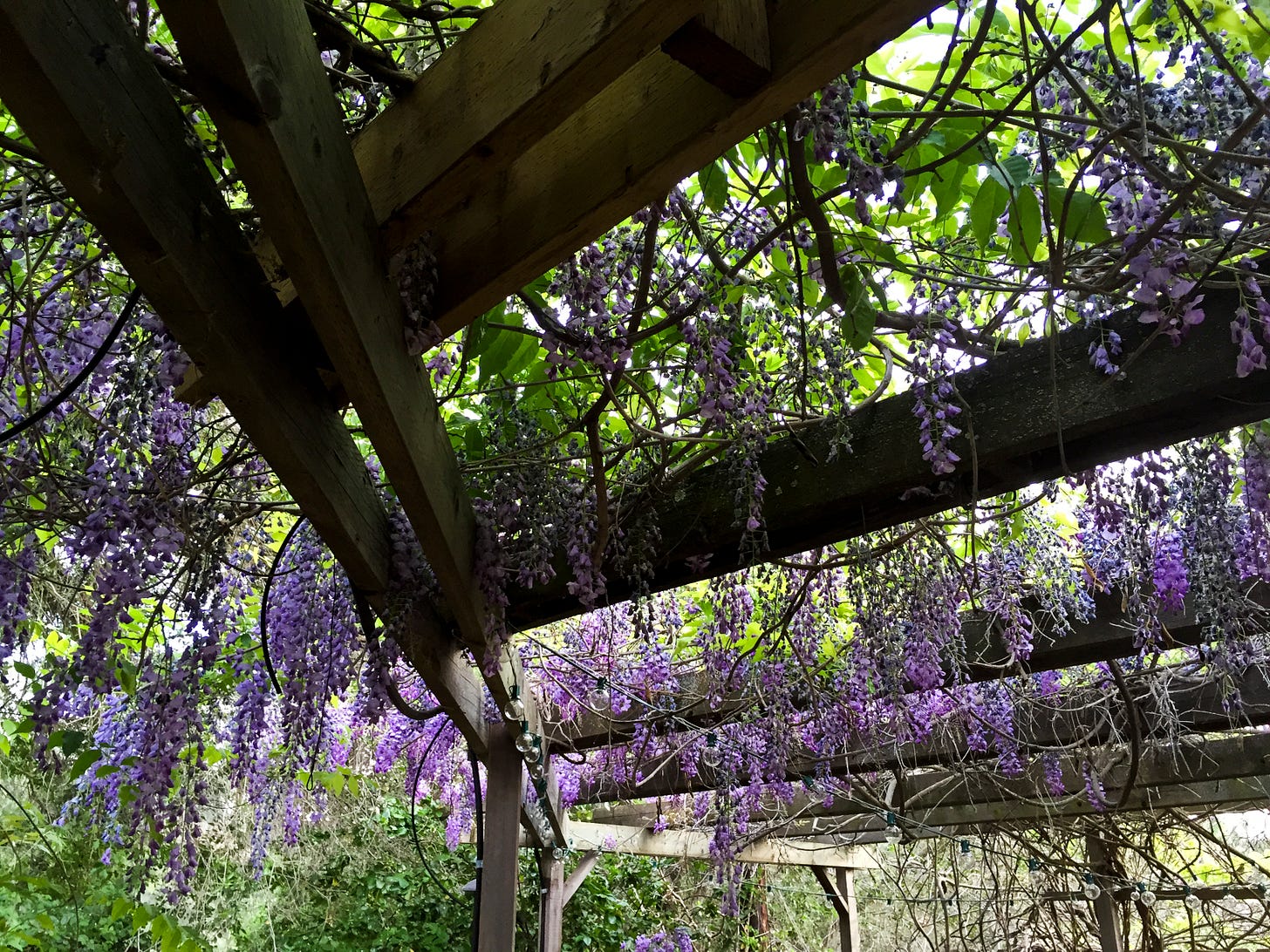
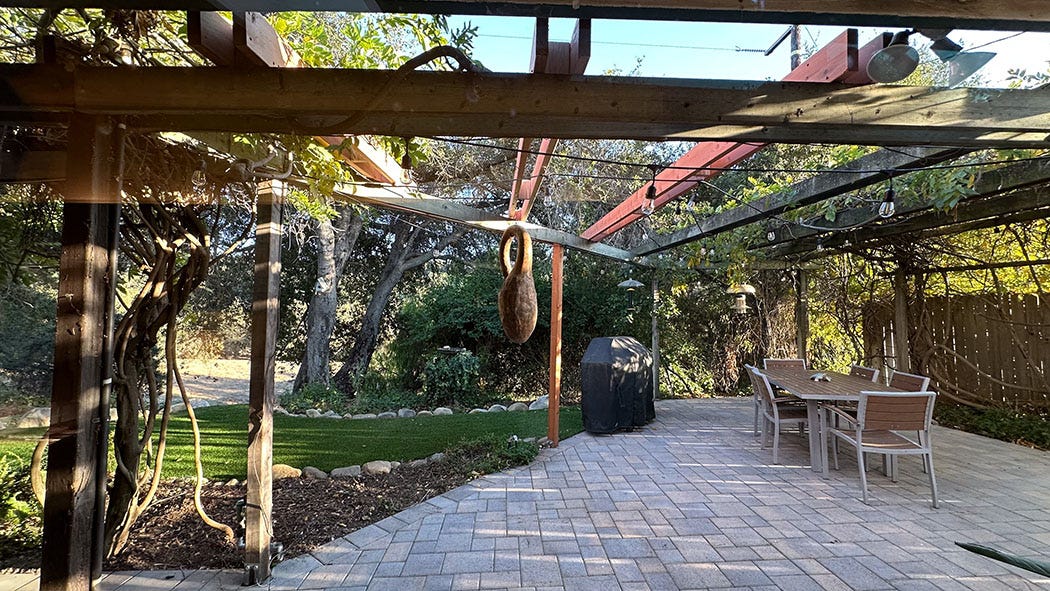

I love reading about your adventures and so enjoy your amazing writing skills. I wish you and Les the happiest of new years. Onward Next Chapter!!
Wow, John and Leslie! I love the pin map at the end, puts it all into perspective. I think it would have been so hard to just pick your favorites with one runner up. Well done as usual. AND to your roof situation...OMGosh. Bet you're pretty glad you had that pergola! Brock had a giant oak tree fall in a similar manner, with no apparent reasons, and it, however, missed the house and the garage. OK can't wait until your next trip and then your stories. Happy New Year!!